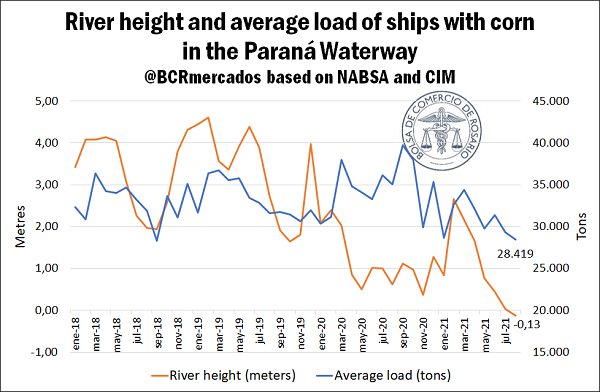Due to the low water level, last month the Paraná river hit its minimum in 50 years. In this context, probable scenarios for the remaining months of the year are far from promising. The average of -0.13 meters high in August does not seem to show that the worst is over. In Rosario, the most critical moment for the Paraná river is forecast for November.
This way, the most optimistic forecast anticipates a height of -0.46 meters for the penultimate month of the year, while in the worst scenarios, the height is forecast at -1.44 meters, according to the National Water Institute (INA, for its Spanish acronym). If this figure comes true, it would be one of the most severely low-water levels on record, very close to the one of 1944, the worst of the series.
In this context, the load of the vessels leaving from the ports of the waterway has been showing a sustained decrease. In the month of August, the load average was around 28,400 tons per vessel loaded with corn, the lowest value in at least three years, and one of the lowest ever recorded.
The depth of the river strongly affects the loading capacity of the vessels. However, Argentina keeps meeting its export obligations even at the expense of locally absorbing the sustained cost increases boosted by the fake freight of those vessels that cannot complete their maximum load capacity and the increased logistic costs due to the need to transport a higher share of the harvest to ports outside the waterway. In this sense, a great share of late corn had to be shipped through the ports in the South of Buenos Aires province, as it was timely highlighted in a previous edition of the Weekly Report.
As for the dynamics of export sales, corn 2020/21 has accumulated 34.7 Mt in Export Sworn Statements (DJVE, for its Spanish acronym), so it is headed to exceed in the next few days the total declared during crop season 2019/20. Therefore, it would be the second crop season with more export sales on record, with potential to exceed the record of 38 Mt set by crop season 2018/19.
In addition, the soybean complex totals export sales for 23.6 Mt so far. Although this total is in line with the sales level of last crop season, this time we are found with 1 Mt more of soybean by-products and 1.1 Mt less of bean, thanks the improvement in the crushing levels.
